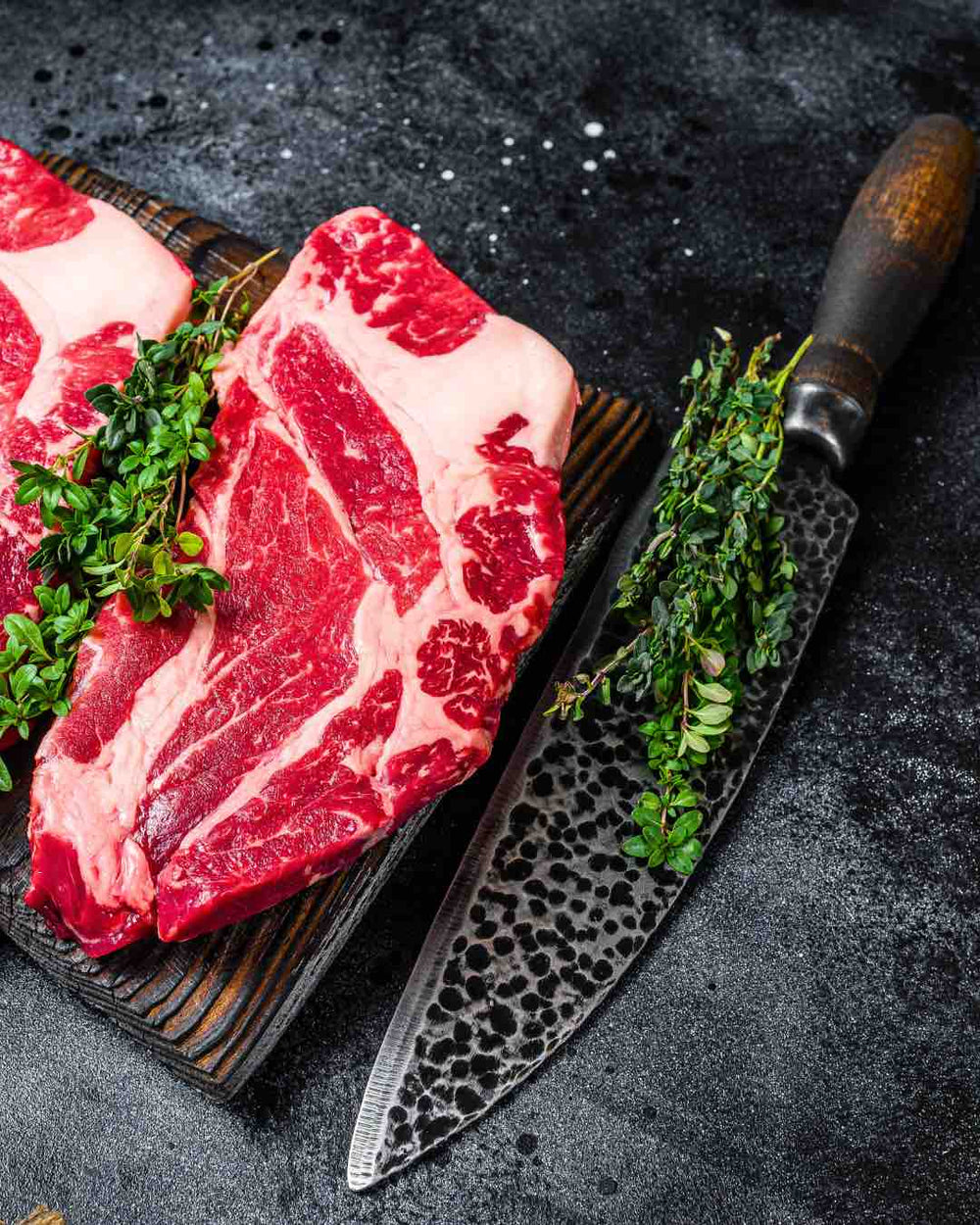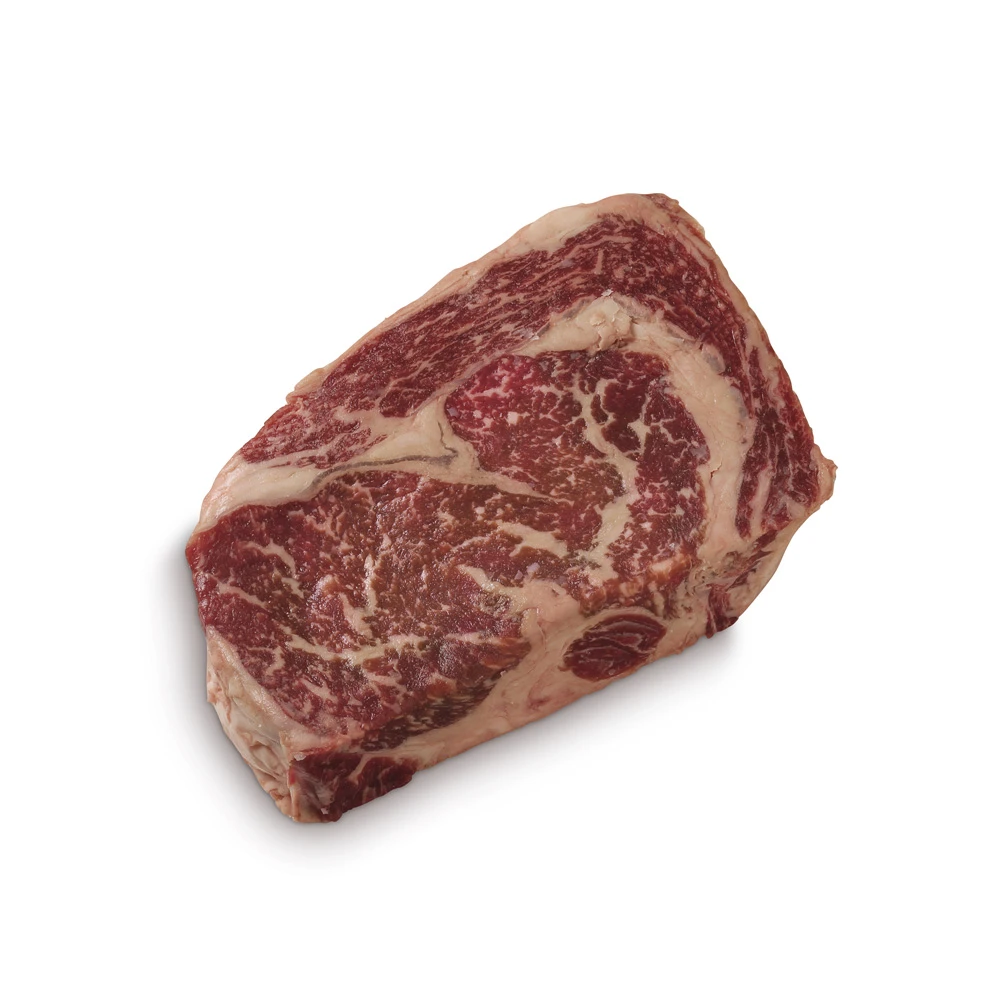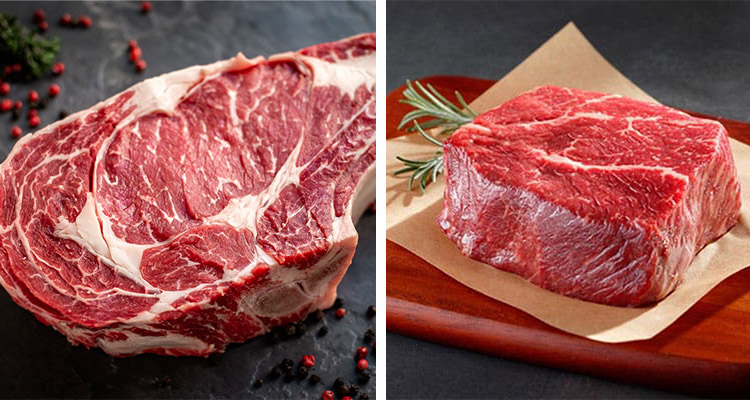
Introduction
When it comes to beef cuts, chuck eye steak and ribeye are two popular choices known for their tenderness and rich flavors. While they share some similarities, distinct differences set them apart. In this blog, we’ll delve into the characteristics of chuck eye steak vs. ribeye, exploring their flavors, marbling, cooking techniques, and more.
Overview Of Chuck Eye And Ribeye Steaks
Chuck eye steak is a cut that comes from the shoulder area of the cow, specifically from the sixth and seventh ribs. It is often referred to as the “poor man’s ribeye” due to its similarity in flavor and tenderness. Chuck eye steak is known for its rich, beefy flavor and moderate marbling, which adds juiciness and flavor to the meat.
On the other hand, ribeye steak is cut from the rib section of the cow, particularly from the rib roast, which is closer to the back of the animal. Ribeye is widely regarded as one of the most flavorful and tender cuts of beef. It has generous marbling, which gives it a buttery texture and enhances its flavors.
Similarities And Differences Between The Two Cuts
There are some similarities between chuck eye steak and ribeye, such as their tenderness and rich flavors. Both cuts can be cooked using various methods, including grilling, pan-searing, and broiling. They also share similar cooking times, usually requiring medium to high heat for a shorter period to retain their juiciness.
However, there are also notable differences between the two cuts:
- Flavor: Chuck eye steak has a rich, beefy flavor, while ribeye has a more pronounced, intense flavor due to its higher fat content and marbling.
- Marbling: Chuck eye steak has moderate marbling, while ribeye is well-known for its generous marbling, which contributes to its tenderness and flavor.
- Price: Chuck eye steak is generally less expensive than ribeye, making it an affordable alternative for meat lovers on a budget.
In conclusion, both chuck eye steak and ribeye offer delicious flavor profiles and tenderness, but they have distinct differences in terms of marbling, flavor intensity, and price. Ultimately, the choice between the two cuts depends on personal preference and budget.
Chuck Eye Steak
Description And Origin Of The Chuck Eye Steak
The chuck eye steak is a cut of beef that comes from the shoulder area of the cow, specifically from the sixth and seventh ribs. It is often referred to as the “poor man’s ribeye” due to its similarity in flavor and tenderness. This cut is believed to be a portion of the ribeye muscle that extends into the chuck area. It is a relatively small and affordable cut compared to the ribeye.
Characteristics And Flavor Profile Of Chuck Eye Steak
Chuck eye steak is known for its rich, beefy flavor, similar to that of a ribeye. It has moderate marbling, which adds juiciness and flavor to the meat. The texture of the chuck eye steak is slightly less tender compared to the ribeye, but it still offers a satisfying bite. Due to the marbling, the chuck eye steak remains moist and flavorful when cooked to perfection.
The chuck eye steak is versatile and can be cooked using various methods, such as grilling, pan-searing, or broiling. It is recommended to cook it to medium-rare or medium to preserve its tenderness and flavors. However, overcooking may result in a tougher texture.
While the chuck eye steak may not have the same level of marbling and tenderness as the ribeye, it is an economical alternative for those looking for a flavorful steak on a budget. Its rich flavor and moderate marbling make it a popular choice among beef lovers.
In summary, the chuck eye steak is a flavorful cut of beef that offers a rich, beefy flavor similar to a ribeye. Its moderate marbling adds juiciness and enhances the overall taste. While it may not have the same tenderness or marbling as ribeye, it is an affordable option that doesn’t compromise on flavor.
Ribeye Steak
Description And Origin Of The Ribeye Steak
The Ribeye steak is a well-known and highly prized cut of beef that comes from the rib section of the cow, specifically from the area around the ribeye muscle. It is renowned for its exceptional flavor, tenderness, and marbling. The Ribeye steak is often considered one of the most flavorful cuts of beef.
Characteristics And Flavor Profile Of Ribeye Steak
The Ribeye steak is famous for its unmatched richness and succulence. Its well-distributed fat throughout the meat not only adds to the beefy flavor but also contributes to its tenderness. The marbling of fat in the Ribeye steak melts during cooking, resulting in a juicy and flavorful eating experience. The texture of the Ribeye steak is incredibly tender, making it melt in your mouth.
Cooking methods like grilling, pan-searing, or broiling are ideal for the Ribeye steak, as they enhance its natural flavors and ensure a juicy and tender outcome. It is recommended to cook the Ribeye steak to medium-rare or medium to preserve its tenderness and meaty flavors. Overcooking can potentially result in a drier texture.
In summary, the Ribeye steak is a highly prized cut of beef known for its exceptional flavor, tenderness, and marbling. It is considered one of the best cuts for steak lovers due to its richness, succulence, and melt-in-your-mouth texture. Whether grilled, pan-seared, or broiled, the Ribeye steak delivers an unparalleled culinary experience.
Cut And Texture Comparison
Variations In Cut And Marbling Between Chuck Eye And Ribeye
The Chuck Eye steak and Ribeye steak are both delicious cuts of beef but have distinct differences in their cut and marbling. The Chuck Eye steak is cut from the chuck primal, which is located near the shoulder of the cow. It is a smaller, narrower cut compared to the Ribeye, which is taken from the rib section. The Ribeye is larger and wider, giving it a more substantial presence on the plate.
In terms of marbling, the Ribeye steak is well-known for its rich marbling, which is the fat distributed throughout the meat. This marbling enhances the flavor and juiciness of the steak. On the other hand, the Chuck Eye steak has less marbling compared to the Ribeye. It still has some fat content, but not as generously distributed as the Ribeye.
Texture Differences And Tenderness Levels
The texture of the Chuck Eye steak and Ribeye steak also differ. The Ribeye steak has a more buttery texture due to the abundant marbling. This marbling melts during cooking, resulting in a tender and juicy eating experience. The Chuck Eye steak, although it has less marbling, still has a good level of tenderness. It is not as buttery as the Ribeye but still offers a satisfying and flavorful bite.
When it comes to cooking, both steaks have their preferred methods. The Ribeye steak is well-suited for grilling, pan-searing, or broiling, as these methods enhance its natural flavors. The Chuck Eye steak can also be cooked using these methods, but it may benefit from marinating or braising to enhance its tenderness.
In conclusion, the Chuck Eye steak and Ribeye steak have variations in their cut, marbling, texture, and tenderness. The Ribeye offers a more buttery texture and intense beefy flavor, thanks to its rich marbling. The Chuck Eye steak, although it has less marbling, still provides a satisfying and flavorful eating experience. Both steaks can be cooked using various methods, depending on personal preferences.

Flavor Showdown
Richness And Succulence Of Ribeye Steak
The Ribeye steak is widely regarded as the ultimate choice when it comes to flavor. Its unparalleled richness and succulence make it a favorite among steak lovers. The well-distributed fat in the Ribeye enhances its beefy flavor and contributes to its tenderness. The marbling, which is the fat distributed throughout the meat, adds a luxurious buttery texture and juiciness to the steak.
Flavor Profile And Taste Of Chuck Eye Steak
Although not as inherently tender as the Ribeye, the Chuck Eye steak offers plenty of flavor. Its taste is robust and hearty, making it a popular choice for those who prefer a more intense beefy flavor. The Chuck Eye steak has a good level of tenderness, although it may require some additional cooking techniques, such as marinating or braising, to enhance its tenderness.
When it comes to choosing between the Chuck Eye steak and Ribeye, it ultimately depends on personal preferences. The Ribeye is known for its exceptional richness, succulence, and buttery texture, while the Chuck Eye steak offers a satisfying and flavorful eating experience with its robust flavor profile.
In terms of cooking methods, both steaks can be cooked using various techniques. The Ribeye steak is well-suited for grilling, pan-searing, or broiling, as these methods enhance its natural flavors. The Chuck Eye steak can also be cooked using these methods, although it may benefit from marinating or braising to further enhance its tenderness.
In conclusion, the Chuck Eye steak and Ribeye steak have distinct differences in flavor, texture, and tenderness. The Ribeye offers a luxurious and buttery experience with its rich marbling, while the Chuck Eye steak provides a robust and hearty flavor. Whichever steak you choose, both will undoubtedly provide a delightful culinary adventure.
Cooking Techniques
Recommended Cooking Methods For Chuck Eye Steak
The Chuck Eye steak can be cooked using various techniques to enhance its flavor and tenderness. Some recommended cooking methods for Chuck Eye steak include:- Marinating: Marinating the Chuck Eye steak before cooking can help to tenderize the meat and add an extra layer of flavor. Choose a marinade that complements the robust taste of the steak, such as a combination of Worcestershire sauce, garlic, and herbs.- Braising: Braising involves slow-cooking the Chuck Eye steak in liquid, such as broth or wine, at a low temperature. This method helps to break down the tough fibers in the meat and results in a tender, flavorful steak.
Recommended Cooking Methods For Ribeye Steak
The Ribeye steak is a versatile cut that can be cooked using various techniques to bring out its rich flavor and tenderness. Some recommended cooking methods for Ribeye steak include:- Grilling: Grilling allows the Ribeye steak to develop a delicious smoky char while retaining its juicy interior. Preheat the grill to high heat and cook the steak for a few minutes on each side until it reaches the desired level of doneness.- Pan-searing: Pan-searing the Ribeye steak in a hot skillet with some oil and butter creates a flavorful crust on the outside while maintaining the moisture inside. Cook the steak for a few minutes on each side until it is browned and cooked to your liking.- Broiling: Broiling is a quick and convenient method for cooking Ribeye steak. Place the steak on a broiler pan and cook it under the broiler for a few minutes on each side until it is caramelized and cooked to the desired doneness.
When cooking Chuck Eye or Ribeye steak, it is important to ensure that the steak is cooked to the proper internal temperature for food safety. Use a meat thermometer to check for the desired doneness, with an internal temperature of 135°F for medium-rare, 145°F for medium, and 160°F for well-done.
Experiment with different cooking techniques and flavors to find the perfect cooking method that suits your taste and preference for each steak cut. Enjoy the flavorful and tender experience of cooking and savoring Chuck Eye and Ribeye steaks.
Price And Availability
Price Differences Between Chuck Eye And Ribeye
When considering the price point of Chuck Eye steak and Ribeye steak, it is important to note that Chuck Eye is a less expensive cut compared to Ribeye. Despite being just as delicious as Ribeye, Chuck Eye steak is more budget-friendly, making it a great choice for those looking to enjoy a flavorful steak without breaking the bank.
Availability And Popularity Of Each Cut
While Ribeye steak can easily be found in most grocery store meat departments, Chuck Eye steak may require a visit to a specialty butcher shop. However, it is worth the effort to search out this cut as it offers a unique and flavorful eating experience. Despite its lesser availability, Chuck Eye steak has gained popularity among food enthusiasts and is considered a hidden gem in the steak world.
When it comes to choosing between Chuck Eye and Ribeye, considering both the price and availability will help you make an informed decision based on your budget and preferences. Whether you opt for the affordability and rarity of Chuck Eye or the convenience and popularity of Ribeye, both cuts offer a delightful dining experience.
Cooking Techniques
Recommended Cooking Methods For Chuck Eye Steak
The Chuck Eye steak can be cooked using various techniques to enhance its flavor and tenderness. Some recommended cooking methods for Chuck Eye steak include:
- Marinating: Marinating the Chuck Eye steak before cooking can help to tenderize the meat and add an extra layer of flavor. Choose a marinade that complements the robust taste of the steak, such as a combination of Worcestershire sauce, garlic, and herbs.
- Braising: Slow-cooking the Chuck Eye steak in liquid, such as broth or wine, at a low temperature helps to break down tough fibers and results in a tender, flavorful steak.
Recommended Cooking Methods For Ribeye Steak
The Ribeye steak is a versatile cut that can be cooked using various techniques to bring out its rich flavor and tenderness. Some recommended cooking methods for Ribeye steak include:
- Grilling: Preheat the grill to high heat and cook the Ribeye steak for a few minutes on each side until it reaches the desired level of doneness. Grilling creates a delicious smoky char while retaining the steak’s juicy interior.
- Pan-searing: Searing the Ribeye steak in a hot skillet with some oil and butter creates a flavorful crust on the outside while maintaining the moisture inside. Cook the steak for a few minutes on each side until it is browned and cooked to your liking.
- Broiling: Broiling is a quick and convenient method for cooking Ribeye steak. Place the steak on a broiler pan and cook it under the broiler for a few minutes on each side until it is caramelized and cooked to the desired doneness.
When cooking Chuck Eye or Ribeye steak, ensure that the steak reaches the proper internal temperature for food safety. Use a meat thermometer to check for the desired doneness, with an internal temperature of 135°F for medium-rare, 145°F for medium, and 160°F for well-done. Experiment with different cooking techniques and flavors to find the perfect cooking method that suits your taste and preference for each steak cut. Enjoy the flavorful and tender experience of cooking and savoring Chuck Eye and Ribeye steaks.

Choosing The Right Cut
Factors To Consider When Choosing Between Chuck Eye And Ribeye
- Price and availability: Chuck Eye is a more budget-friendly option compared to Ribeye. However, Ribeye is more commonly available in grocery stores while Chuck Eye may require a visit to a specialty butcher shop.- Flavor and tenderness: While Ribeye is known for its tenderness and buttery taste, Chuck Eye offers a rich beefy flavor despite being a less tender cut.- Cooking techniques: Both cuts can be cooked using various methods, but Chuck Eye benefits from marinating and braising, while Ribeye is best grilled, pan-seared, or broiled to enhance its flavor and tenderness.
Personal Preferences And Recommendations
- If you prioritize tenderness and a buttery taste, the Ribeye is a great choice. It is especially popular among steak lovers and can be easily found in most grocery stores.- If budget-friendliness is a consideration, the Chuck Eye is a more affordable option without compromising on flavor. It may require additional effort to find but is considered a hidden gem in the steak world.- Ultimately, choosing between Chuck Eye and Ribeye comes down to personal preference. Consider your budget, desired level of tenderness, and preferred cooking techniques to make an informed decision.
When cooking either cut, ensure that the steak reaches the proper internal temperature for food safety. Experiment with different cooking techniques and flavors to find the perfect cooking method that suits your taste and preference for each steak cut. Enjoy the flavorful and tender experience of cooking and savoring Chuck Eye and Ribeye steaks.
Conclusion
Recap Of The Key Differences And Similarities
- Chuck Eye is more budget-friendly compared to Ribeye, but Ribeye is more commonly available in grocery stores.- Ribeye is known for its tenderness and buttery taste, while Chuck Eye offers a rich beefy flavor.- Both cuts can be cooked using various methods, but Chuck Eye benefits from marinating and braising, while Ribeye is best grilled, pan-seared, or broiled.
Final Thoughts On The Chuck Eye Vs Ribeye Beef Steak Battle
Regardless of whether you choose Chuck Eye or Ribeye, you’re in for a delightful culinary adventure. The Ribeye triumphs in flavor with its unparalleled richness and succulence due to its well-distributed fat. However, the Chuck Eye still offers plenty of flavor, making it a hidden gem in the steak world.
Ultimately, the decision between Chuck Eye and Ribeye boils down to personal preference. Consider your budget, desired tenderness, and preferred cooking techniques to make an informed choice. When cooking either cut, ensure the steak reaches the proper internal temperature for food safety. Experiment with different cooking techniques and flavors to find the perfect method that suits your taste and preference.
Whichever cut you choose, both Chuck Eye and Ribeye steaks promise a flavorful and tender dining experience. So go ahead, savor the deliciousness of these beef cuts and enjoy the culinary journey they offer.
FAQ: Chuck Eye vs Ribeye – Beef Steak Battle
Q: What is Chuck Eye and Ribeye steak?
Chuck Eye and Ribeye are two popular cuts of beef steaks. Both come from the rib section of the beef, but they differ in terms of texture, tenderness, and flavor.
Q: What is the difference between Chuck Eye and Ribeye?
The main difference lies in the location of the cuts. Chuck Eye is a continuation of the Ribeye muscle, located in the front shoulder area, closer to the chuck primal. Ribeye, on the other hand, is cut closer to the rib primal, which makes it a premium cut with more marbling, tenderness, and flavor.
Q: Which steak is more tender, Chuck Eye or Ribeye?
Overall, Ribeye tends to be more tender than Chuck Eye. The higher fat content and marbling in the Ribeye contribute to its tenderness and juiciness. However, a well-cooked Chuck Eye can still be satisfyingly tender and flavorful.
Q: Which steak has better flavor, Chuck Eye or Ribeye?
Ribeye is often considered to have superior flavor due to its marbling and fat distribution, which adds richness, juiciness, and a melt-in-your-mouth texture. Chuck Eye, though less marbled, can still offer excellent flavor, especially when properly seasoned and cooked.
Q: Are both cuts suitable for grilling?
Absolutely! Both Chuck Eye and Ribeye are excellent choices for grilling. The higher fat content of Ribeye helps prevent the steak from drying out, while the Chuck Eye benefits from seasoning and marinating to enhance its flavor and tenderness.
Q: How should Chuck Eye and Ribeye be cooked?
Chuck Eye and Ribeye can be cooked using various methods such as grilling, pan-searing, or broiling. It’s recommended to cook both steaks to medium-rare or medium for optimal tenderness and flavor. However, personal preferences may vary.
Q: Are Chuck Eye and Ribeye similar in price?
No, Chuck Eye tends to be more affordable compared to Ribeye. Ribeye is considered a premium cut and often commands a higher price due to its tenderness and flavor profile. Chuck Eye, being a less common cut, is usually more budget-friendly.
Q: Can I use Chuck Eye as a substitute for Ribeye?
While Chuck Eye can be a flavorful and affordable alternative to Ribeye, it may not have the same level of tenderness or marbling. However, if cooked properly, Chuck Eye can still result in a delicious steak experience.
Q: Which cut is the best choice for steak lovers?
For steak lovers seeking the utmost tenderness and flavor, Ribeye is generally the go-to choice. But, if you’re looking for a more budget-friendly option without compromising too much on taste, Chuck Eye is a fantastic alternative.
In summary, Ribeye is known for its exceptional tenderness and flavor due to its higher fat content and marbling. However, Chuck Eye offers a more affordable option and can still provide a flavorful and enjoyable steak experience. The choice comes down to personal preferences and budget.

We are family-owned and operated. We love to serve coffee to our community that loves to drink it! We opened in December 2017 and are always expanding and evolving. We strive to offer a relaxing and comfortable gathering place for our customers. We not only serve delicious coffee but a full breakfast and lunch menu as well. You can also order ONLINE through our website or call ahead and pick it up right at our drive-thru window! We have a wide range of delicious baked goods, sweet treats, and a gift shop coming soon! Stop in and let us serve you!!